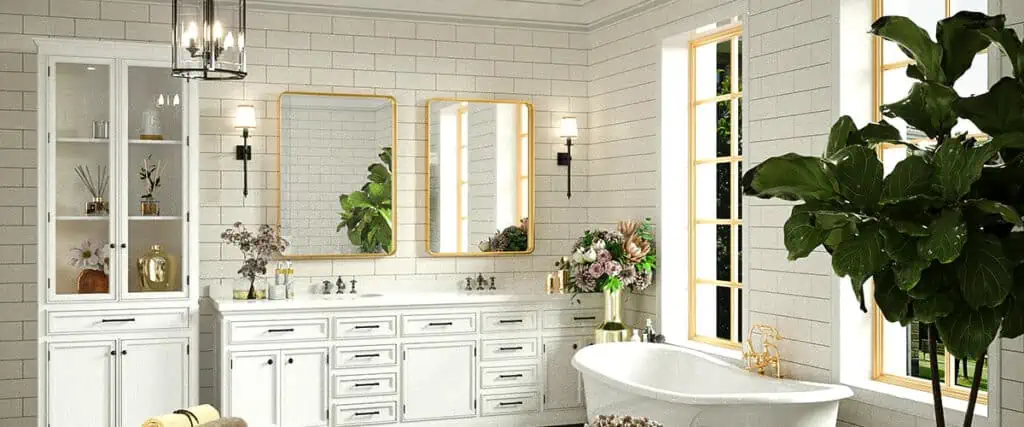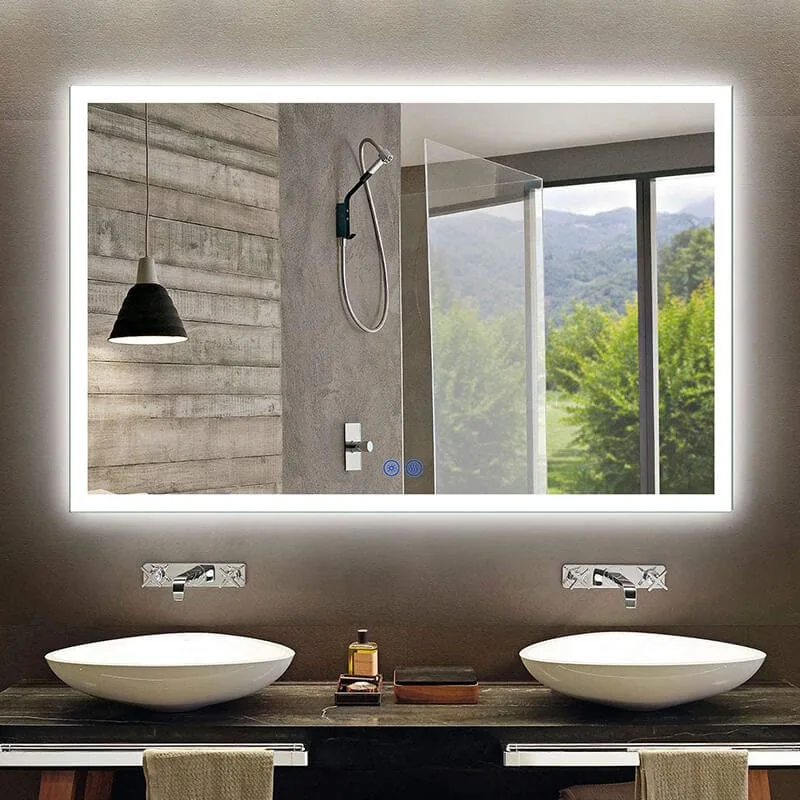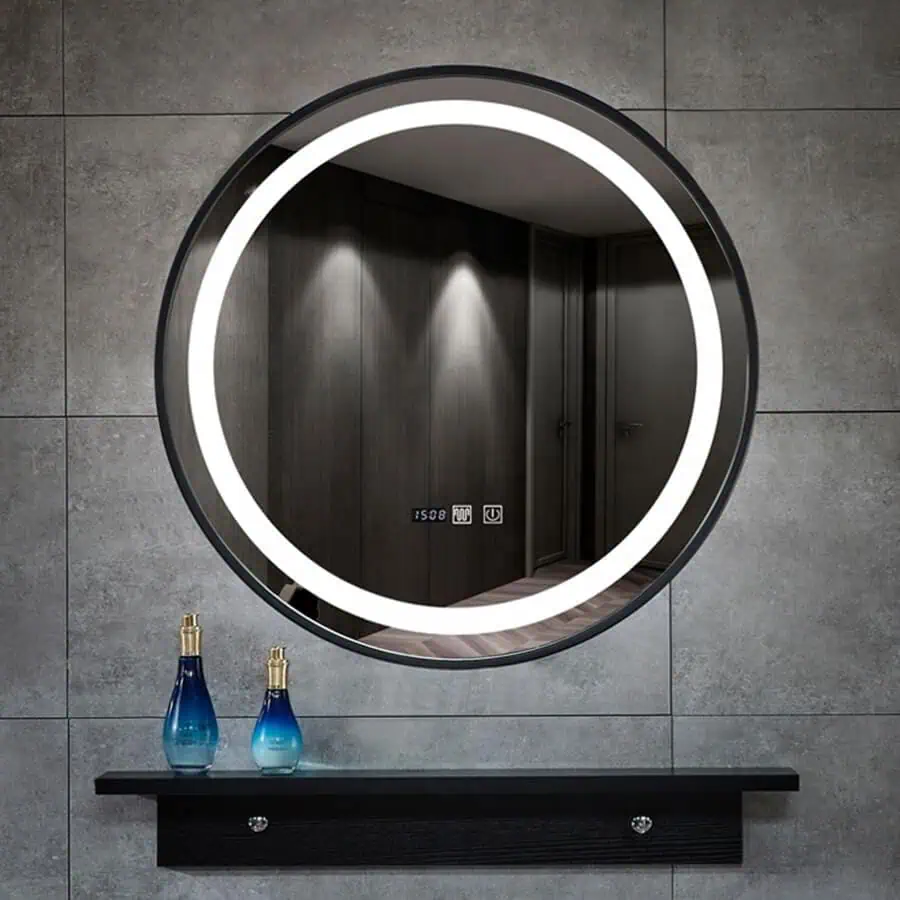Table of Contents
ToggleIntroduction
With the development of bathroom decorations, custom LED mirrors are showing a rapidly growing trend. This is because LED mirrors can not only illuminate and reflect the face, but also bring a lot of convenience to life. Super practical functions with personalized mirrors have become a popular choice for many users.
In addition to lighting, LED mirrors can also make a room larger, more coordinated, and full of atmosphere. So how do you customize a perfect mirror? From selecting the perfect size and shape to choosing additional features like lighting and functionality, this ultimate guide will walk you through the process step by step.
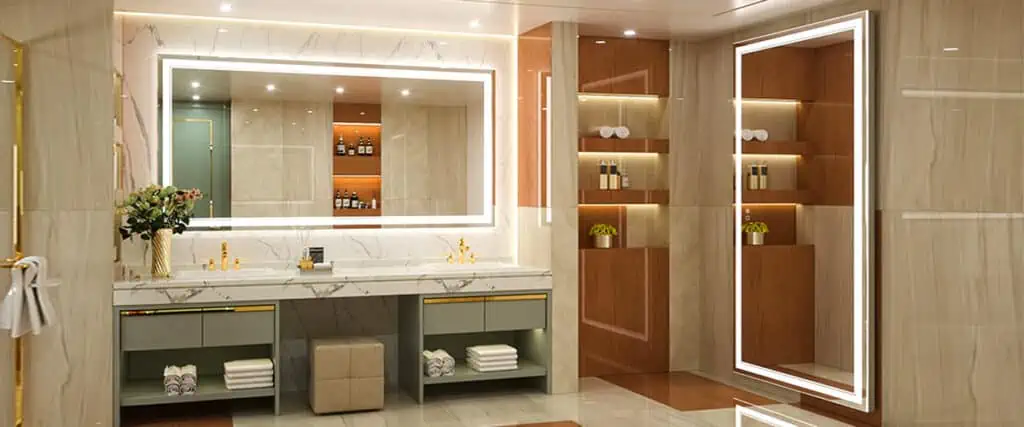
Ⅰ. Composition Of LED Mirrors
Before customizing a smart mirror, let’s learn about the composition of the LED mirror, which is more conducive to choosing the right mirror
1. Mirror
The primary component of the LED mirror is the mirror glass itself, which is typically made of high-quality materials such as float glass or silver-coated glass.
2. LED Light
Embedded within the mirror frame or behind the mirror surface, LED lighting provides illumination for the mirror. LED light is energy-efficient and long-lasting, providing consistent and uniform lighting.
3. Electrical Components
LED mirrors contain electrical components such as LED drivers, wiring, and controls for powering and controlling the LED lighting. These components ensure proper functionality and operation of the LED lights.
4. Frame
LED mirrors can be fitted with a frame or acrylic shell that surrounds the mirror and houses the LED lighting components. The frame material is aluminum alloy, usually black or gold. Different frames are matched with different styles of design, making mirrors very popular.
5. Optional Functions
Include defogging, Bluetooth speakers, magnification features, temperature displays, or touch controls may be included.
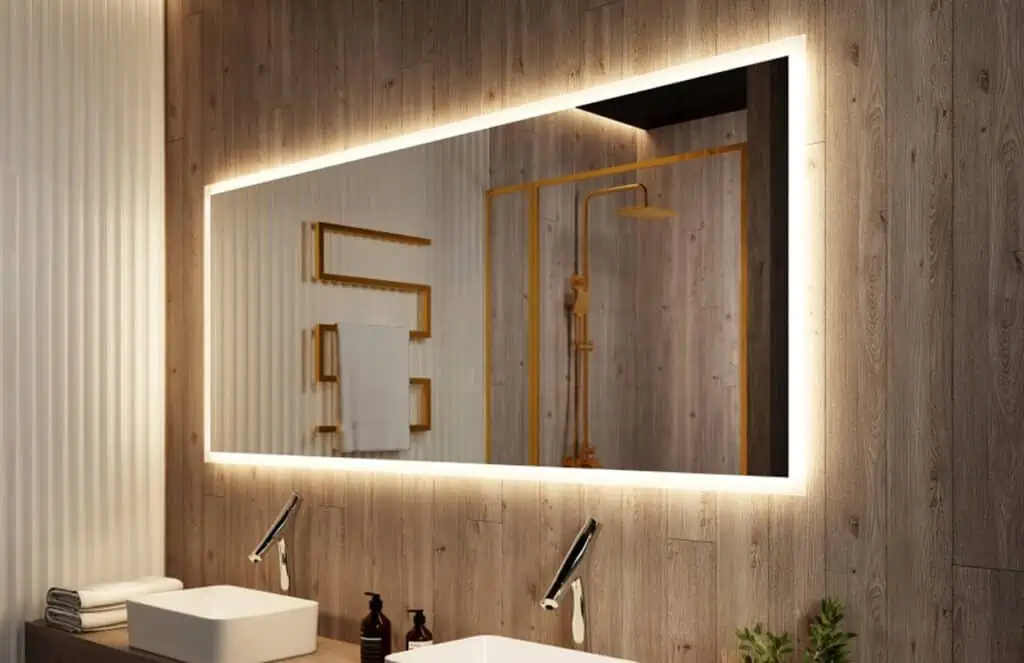
Ⅱ. LED Mirror Comprehensive Customization Guide
We have just learned about the components of LED mirrors. Now let’s focus on more product details.
1. Style & Shape
LED mirrors come in a variety of shapes to suit different preferences. From classic rectangles to elegant ovals, vintage round to unique geometric designs, the shape of LED mirrors affects the overall beauty of this room. Rectangle mirrors are more modern and simple, while round mirrors are softer and silkier. Irregularly shaped mirrors add more interest to the room.
LED mirrors are available in a variety of sizes, whether it’s a small mirror for the bathroom or vanity, or a large full-length mirror for the dressing room, to meet all your requirements. Choosing the right size can make a small room visually more spacious and a large room look more harmonious.
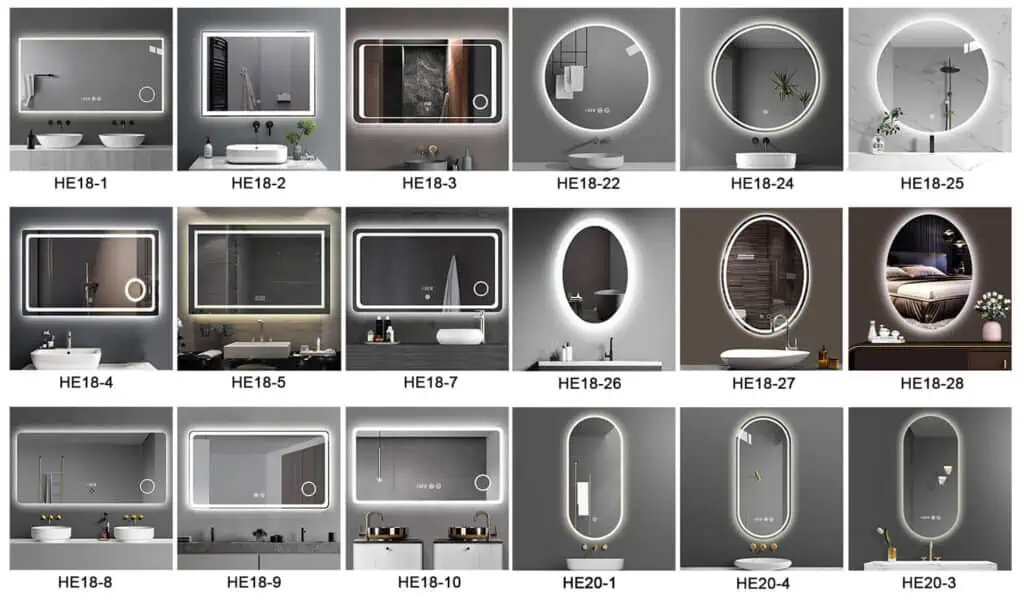
2. Functions
Now that we understand the size and style, let’s take a closer look at the practical functions of LED mirrors.
- Switch Type
The switch type of an LED mirror refers to the method used to control the mirror’s lighting. Common switch types include touch switches and motion sensor switches.
Touch switch, just tap your finger, the user can adjust the brightness or color temperature of the LED light, activate functions such as defogging or Bluetooth, and turn the light on or off.
LED mirror motion sensor switches utilize infrared technology to detect motion within a certain range. When someone approaches the mirror, the sensor activates the lights automatically, providing hands-free operation. And the lights automatically turn off when no motion is detected, helping to conserve energy.
- Defogging
The defogging function is the most popular and practical feature, keeping the mirror clear and free of water mist, even in humid environments such as bathrooms. Using an integrated heating element behind the mirror, the defogging function prevents condensation from forming on the mirror surface by gently warming it. The defogging function is activated automatically when the mirror is turned on, and it works efficiently to maintain a clear reflection, eliminating the need to manually wipe away condensation.

- Adjustable Brightness And Color Temperature
LED mirrors with adjustable brightness and color temperature offer users greater control over their lighting experience.
The brightness can be customized to suit different lighting needs, whether it is for a delicate makeup or to increase the atmosphere, the function of adjusting the brightness is very practical.
The color temperature can be adjusted from warm to white, allowing users to create the right makeup according to their needs, whether it is natural light suitable for outdoor activities or cool white light for attending banquets.
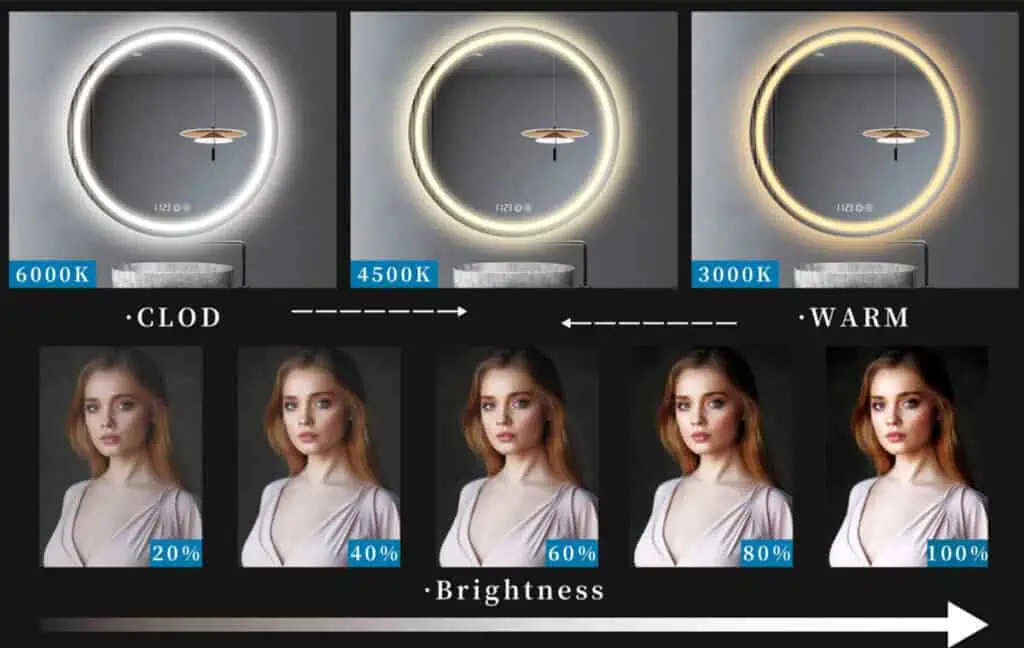
- RGBW Light
LED mirrors with RGBW (Red, Green, Blue) lights offer an extensive range of lighting options to users. Whether it’s vibrant hues for a lively atmosphere or soothing pastels for relaxation, the RGBW feature allows for endless customization possibilities.
- Magnifier
The LED mirror with magnification function is more conducive to skin care and makeup, such as sticking eyelashes, painting eyeliner, shaving, etc., which is a very practical function. Typically located on one side of the mirror, the magnifier offers varying levels of magnification, such as 2x, 5x, or 10x.
- Digital Clock
LED mirrors with a digital clock function offer added convenience and functionality to users. Integrated seamlessly into the mirror’s design, the digital clock displays the current time directly on the mirror surface. The temperature reading function allows users to monitor the indoor temperature conveniently while going about their daily routines in the bathroom or dressing area. With the digital clock function, users can easily keep track of time while performing their daily routines, enhancing efficiency and organization in their space.
- Bluetooth
The Bluetooth function in LED mirrors enables seamless connectivity with external devices such as smartphones or music players. By pairing the mirror with a Bluetooth-enabled device, users can stream their favorite music, podcasts, or audiobooks directly through the mirror’s built-in speakers, enhancing the overall experience of getting ready in the bathroom. Additionally, Bluetooth connectivity allows for hands-free calling, enabling users to answer phone calls without interrupting their grooming routine.
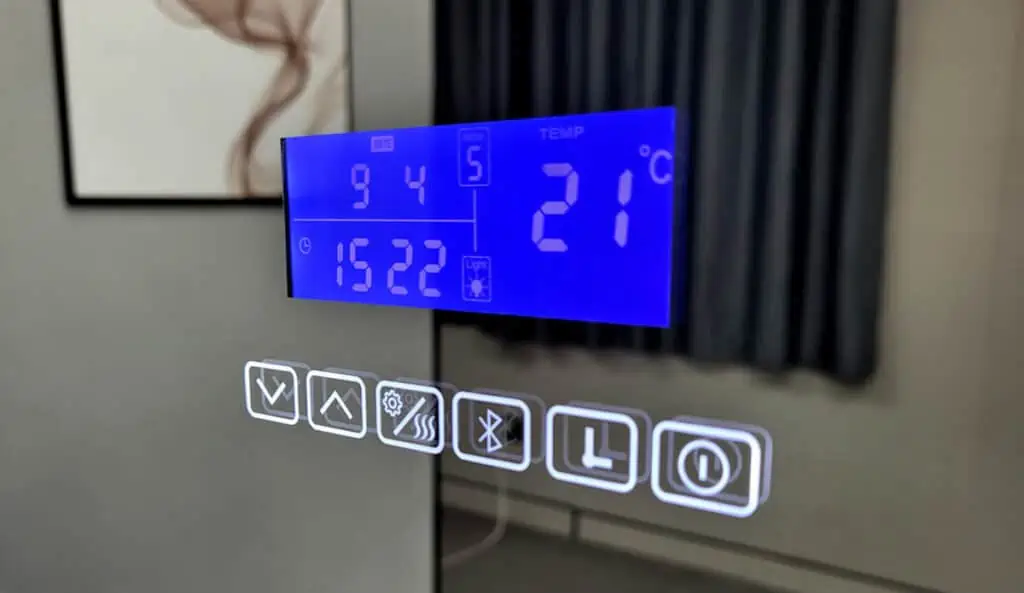
3. Choose LED Strip
After understanding the functions of LED mirrors, we also need to consider LED light strips
- Chip Type
LED strips commonly utilize two chip types: 2835 and 5050.
2835 chip, smaller in size, offers higher density and more uniform lighting. It’s ideal for applications requiring precise illumination, such as task lighting or accentuating details.
5050 chip, larger and more powerful, provides brighter and more intense illumination. It’s suitable for ambient lighting and applications where higher brightness is desired, such as general room lighting or decorative lighting.
Both chip types have their unique advantages.
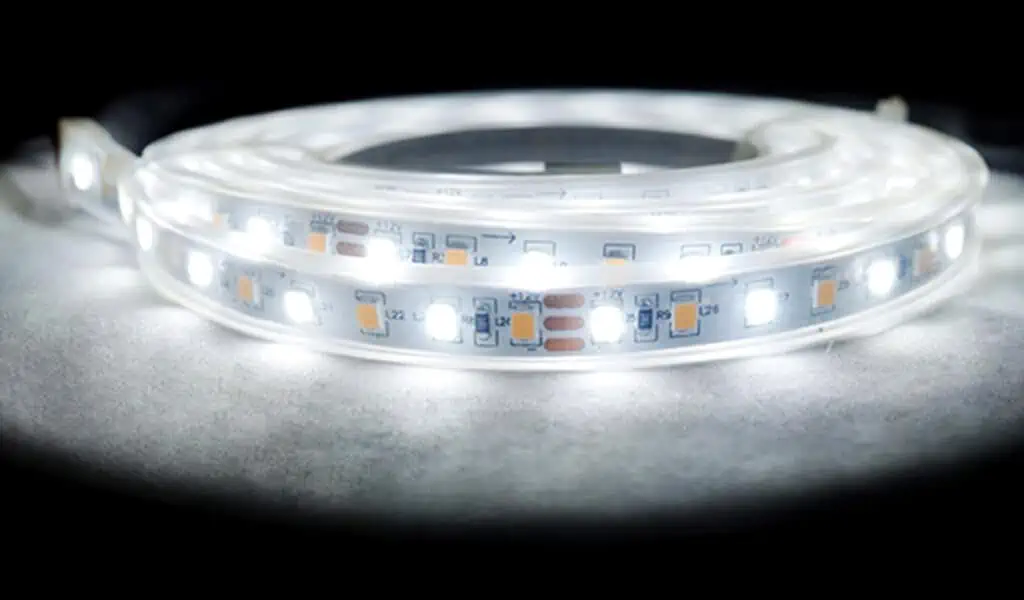
- Number Of LED Chips
LED strips typically come in different configurations, with options for varying densities of LED chips per meter or foot. Common configurations include 30, 60, 120, or even 240 LED chips per meter, providing flexibility in brightness and illumination levels. Higher chip densities result in brighter and more uniform lighting, making them suitable for applications where increased brightness and precision illumination are desired, such as task lighting or accent lighting. Conversely, lower chip densities may be preferred for applications where a softer or more diffused light is desired, such as ambient lighting or decorative lighting.
- CRI
A higher CRI value, typically ranging from 0 to 100, indicates better color accuracy and rendering. LED strips with a high CRI value, such as 80 or above, produce light that closely resembles natural sunlight, making them ideal for applications where color fidelity is crucial, such as in retail displays, art galleries, or makeup studios. A higher CRI ensures that colors appear vibrant, true-to-life, and accurately represented under the LED strip’s illumination.
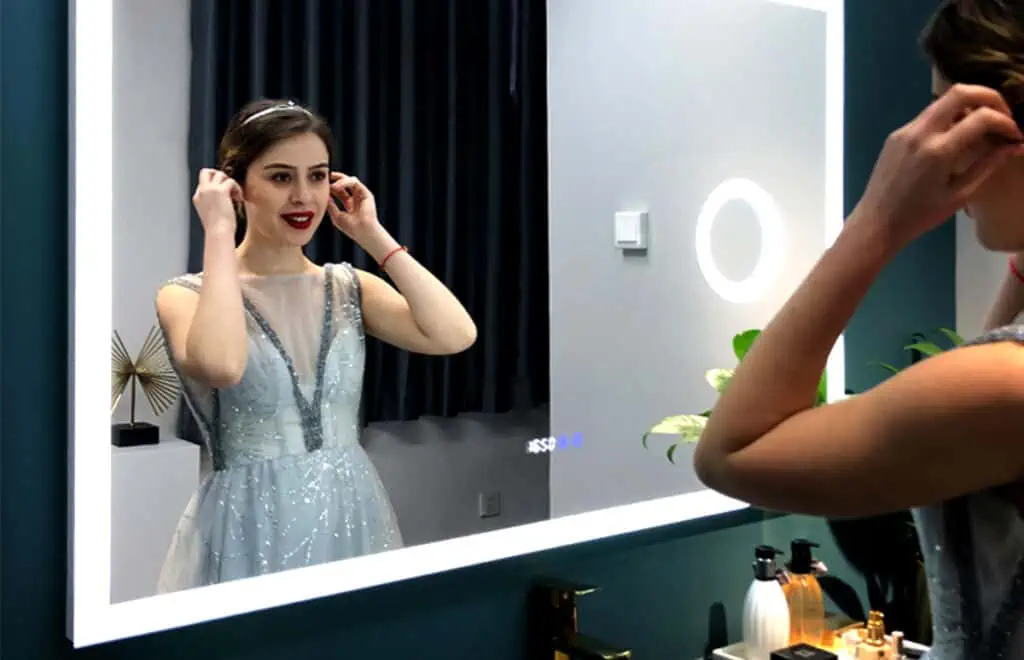
- Lighting Of The LED Strip
Single-color: These strips emit light in a single color, such as warm, white, natural, or any other specific color. They are commonly used for ambient lighting, accent lighting, or decorative purposes where a consistent color tone is desired.
Double-color: Also known as dual-color or bi-color LED strips, these strips feature LEDs that can emit light in two different colors. Typically, these strips alternate between two colors, allowing for dynamic lighting effects or mood lighting. They are often used in applications where color-changing capabilities are desired, such as architectural lighting or interior décor.
Tricolor: These light strips can emit white light, natural light, and warm light. Whether it is for makeup or to enhance the atmosphere, it is a good choice.
4. Choose Driver
After dealing with the led strip, the led driver must be given priority as well.
The Philips Xitanium LED Driver is a high-performance lighting solution designed to provide reliable and efficient power management for LED luminaires, including LED mirrors.Built to withstand harsh operating conditions and extended use, the Xitanium LED Driver is highly reliable and durable, providing long-lasting performance and minimal maintenance requirements.
Incorporating state-of-the-art technology and advanced features, the Lutron LED Driver delivers superior performance and reliability, ensuring optimal lighting quality and efficiency. Lutron LED Driver is a top-of-the-line lighting control solution that offers smooth dimming, compatibility, energy efficiency, and reliability, making it an ideal choice for powering LED mirrors and other lighting fixtures.
Meanwell LED drivers are renowned for their high efficiency, reliability, and versatility, making them an ideal choice for powering LED mirrors. With a reputation for durability and reliability, Meanwell LED drivers provide stable and consistent power output, minimizing the risk of flickering or voltage fluctuations that can affect LED mirror performance.
5. Plug Or Wiring
The plug and wiring of an LED mirror are crucial components that ensure proper electrical connectivity and safety.
Plug: LED mirrors typically come with a standard plug that allows them to be easily connected to a power outlet. The plug may vary depending on the region’s electrical standards, such as Type A, Type C, or Type G plugs. It ensures a secure and reliable connection to the power source.
Wiring: The wiring of an LED mirror includes the cables and connectors that transmit electricity from the plug to the internal components of the mirror, such as the LED lights and additional features like Bluetooth or defogging functions. High-quality wiring is essential for ensuring efficient power distribution and preventing electrical hazards.
The plug and wiring of an LED mirror should be durable and resistant to wear and tear, as they are subjected to frequent handling during installation and maintenance. High-quality materials and construction ensure long-term reliability and performance.
Overall, the plug and wiring of an LED mirror play a crucial role in providing safe and reliable electrical connectivity, ensuring proper functionality, and enhancing user experience.

Ⅲ.Choose A Suitable LED Mirror Manufacturer
We have clarified the composition of the mirror, its function, and the relevant information of the LED light strip, and now we need to proceed to the next important step, selecting the right custom mirror manufacturer.
1. Reputation and Experience
Assess how long the manufacturer has been in the LED mirror industry. Longer tenure often indicates a wealth of experience and knowledge accumulated over the years. Check if the manufacturer has received any awards, certifications, or accolades within the LED mirror industry. These recognitions can validate their expertise and commitment to excellence.

2. Product Quality
High-quality materials, such as premium-grade glass for the mirror surface and durable metals for the frame and components, are essential for longevity and resistance to wear and tear. The precision and skill employed in the manufacturing process determine the mirror’s finish, detailing, and overall aesthetics. Attention to detail and meticulous craftsmanship are indicative of superior quality.
3. Customization Options
Choose a manufacturer that offers customization options to meet your specific requirements. This includes the ability to customize mirror size, shape, lighting features, and additional functionalities like Bluetooth connectivity or magnification.
4. Production Capacity
Assess the manufacturer’s production capacity to ensure they can meet your demand for LED mirrors. Inquire about their manufacturing facilities, equipment, and workforce capabilities to determine if they can handle large-scale orders efficiently.
HIXEN With advanced equipment and machinery, we can efficiently produce a high volume of LED mirrors to meet the demands of our clients. Our streamlined production process ensures optimal efficiency and precision at every stage, from raw material procurement to final assembly and quality control. Additionally, our flexible production capabilities allow us to accommodate varying order sizes and customization requirements without compromising on quality or lead times. Whether it’s large-scale production runs or customized projects, HIXEN is equipped to deliver superior LED mirrors promptly and reliably, ensuring customer satisfaction every time.

5. Certifications
Certifications play a crucial role in establishing the credibility and reliability of an LED mirror manufacturer. These certifications serve as tangible evidence that LED mirrors meet stringent quality and safety standards set by regulatory bodies and industry organizations. For instance, certifications such as CE, UL, and ETL demonstrate compliance with European and North American safety regulations, ensuring that LED mirrors are safe for use in homes and commercial settings.
6. R & D Capabilities
The research and development (R&D) capabilities of an LED mirror manufacturer are paramount in driving innovation, staying ahead of market trends, and continuously improving product offerings. With robust R&D capabilities, LED mirror manufacturers can develop cutting-edge technologies, enhance product functionality, and introduce innovative designs that meet the evolving needs and preferences of customers.
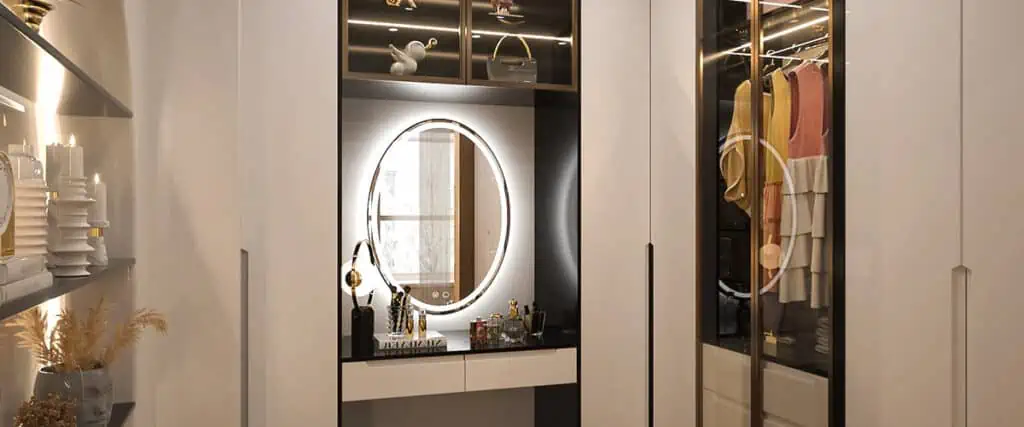
7. R&D Team
The R&D team of an LED mirror manufacturer plays a pivotal role in driving innovation, enhancing product quality, and staying ahead of market trends. A skilled R&D team enables the manufacturer to continuously improve existing products, introduce new offerings, and adapt to changing customer preferences and industry standards. Their ability to solve complex technical challenges, conduct thorough testing, and incorporate feedback from customers ensures that the company delivers cutting-edge LED mirrors that meet the highest standards of performance, durability, and aesthetics. Ultimately, the R&D team’s contributions are essential for maintaining the company’s competitive edge, driving growth, and solidifying its reputation as an industry leader.
Questions Answered
Are LED mirrors safe?
Yes, LED mirrors are generally considered safe when manufactured and installed properly. LED mirrors undergo rigorous testing to ensure compliance with safety standards and regulations. Additionally, they are designed with built-in safety features to prevent electrical hazards, such as short circuits and overheating. However, it is essential to purchase LED mirrors from reputable manufacturers that adhere to quality standards and provide proper installation instructions. Regular maintenance and inspection can also help ensure the ongoing safety and performance of LED mirrors.

How long do LED-lighted mirrors last?
LED-lighted mirrors typically have a long lifespan compared to traditional incandescent or fluorescent lighting. On average, LED bulbs can last up to about 50,000 hours or more, depending on usage and quality. With typical daily use, an LED-lighted mirror can last for many years without needing replacement. Additionally, LED technology is known for its energy efficiency and durability, making LED-lighted mirrors a long-lasting and cost-effective lighting solution for bathrooms and other spaces.
Are LED mirrors bright enough?
Yes, LED mirrors are typically designed to provide ample brightness for various tasks such as grooming, applying makeup, or shaving. The brightness of an LED mirror depends on factors such as the quality of the LEDs used, the wattage of the bulbs, and the size of the mirror. Many LED mirrors feature adjustable brightness settings, allowing users to customize the lighting to their preferences. Additionally, newer LED technology often offers improved brightness and energy efficiency compared to traditional lighting options.
Conclusion
This article explains the precautions for customizing LED mirrors, hoping to be helpful to you. If you are looking for a suitable supplier, why not choose HIXEN? We have more than ten years of experience in the mirror industry, and customizing LED mirrors for customers is our specialty. If you are interested, please contact us.

